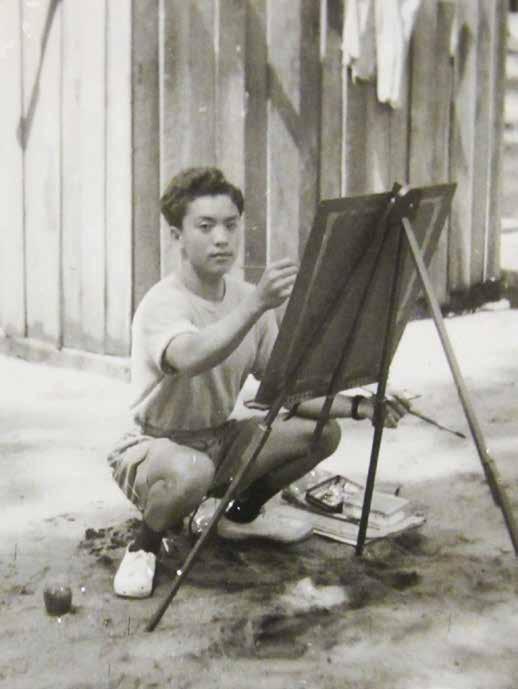
5 minute read
Looking at Paintings
from Jolly @ 80
In the words of the late philosopher Hector-Neri Castenada “We exercise our thinking powers in learning what things are and how they relate to, and affect, one another. We postulate hypotheses and invent theories about what things are and how they affect one another. These are all instances of thinking in which one contemplates the world, its contents, and its laws. They are variously referred to as descriptive, or theoretical, or contemplative, or pure uses of reason. Here we shall call them instances of contemplative or propositional thinking.“
Thus when we look at or even just think about paintings we could engage in propositional thinking as when we formulate art theories or philosophies of art. Or, when we study the history of art or the biography of artists. These activities are examples of propositional thinking when we study paintings.
Advertisement
But when I visit the National Gallery in London as an art lover to look at the paintings in it, do I engage in propositional thinking? Do I theorise or speculate on the nature of those paintings? Or, even ask the question whether those paintings are art, or even inquire into the ontological status of those paintings. The answer is, of course, an emphatic no. I visit the Gallery to enjoy those paintings, in a similar way that I attend a concert to enjoy music. In other words, my enjoyment of paintings is non-propositional. That is to say, aesthetic enjoyment is non-propositional. I do not gain any knowledge or gain any insights from my aesthetic enjoyment.
The obvious question is, what is the source of this enjoyment, or, alternatively, what is it about the painting that causes this enjoyment? It is the good organisation of the sensory structure that is the source of my aesthetic pleasure. One of my favorite paintings is Titian’s Bacchus and Ariadne in The National Gallery in London. It is a painting that I have looked at many times over many years and never tire from the enjoyment I derive from its complex sensory structure.
The obvious question now is, what distinguishes a good sensory structure from a poor one? The answer can only be given in front of a good or poor painting. And from the good or poor sensory structure of a painting one could deduce or formulate certain organizing principles. But even from those principles, one must again return to actual paintings to discern how those principles apply or do not apply. David Hume, in his limpid words, put the matter in the following:
“It appears then, that amidst all the variety and caprice of taste, there are certain general principles of approbation or blame, whose influence a careful eye may trace in all operation of the mind. Some particular forms or qualities, from the original structure of the internal fabric, are calculated to please, and others to displease.”
I venture to speculate that a certain sensory structure of a painting provides a sensual manifestation of the structure within the mind and that it is this correspondence that gives pleasure that I call the aesthetic experience. And I believe that it is this correspondence between the complex sensory structure and the structure of the mind that makes Kant’s claim on the universality of aesthetic judgment a possibility.
I speak always of the complex sensory structure of a painting. One may well ask: What of the all black paintings of Malevich?, or of the minimalist painters? My experience of such paintings is one of visual boredom.
One might claim that my view of paintings is too narrow since good paintings have a plurality of values such as historical and cultural values, ideological and narrative values. But the question is: which of these many values provides one with enjoyment, particularly, aesthetic enjoyment? My answer, of course, is that it is the good sensory structure of a painting that provides the aesthetic enjoyment while those other values do not since they are propositional in nature, It is also the aesthetic qualities of paintings that allow the art lover to enjoy paintings across centuries and across different cultures – to enjoy a Monet as well as a Liang Kai or a Hokusai – to enjoy them without understanding their propositional contents.
For many people, paintings may arouse powerful emotional responses but the basis for such a response is the propositional content of the paintings, the propositional contents of which are of social/cultural or personal in nature. While the propositional contents of paintings may contribute to one’s understanding and appreciation of paintings, they do not entail the aesthetic experience.
While some might claim that my enjoyment of paintings is too limiting, but for a lover of good paintings, aesthetic enjoyment is huge. On a related issue, E. H. Gombrich has this to say, “It is a great work of art not because it has so many meanings, but because it is beautiful.”
One might encapsulate the two different approaches to paintings thus:
a. To understand paintings (which is propositional in nature, or belonging in the area of knowledge),
and
b. To enjoy paintings (which is emotional/affective in nature, or belonging in the area of aesthetic pleasure).
These two approaches to paintings are radically different from one another; the first being propositional in nature and the other belongs in the affective/emotional domain.
I believe that Francis Bacon was the most intelligent artist of all the other artists and he has this to say on the matter: “The most important thing is to look at the painting, to read the poetry or to listen to the music. Not in order to understand or to know it, but to feel something.” ( from in interview with Michel Archimbaud in 1992 soon before Bacon died.)
Dr. Jolly Koh July 2021



Some of Jolly’s outdoor sketching photos in Malacca from 1955-1957.








